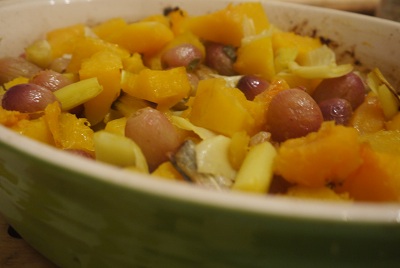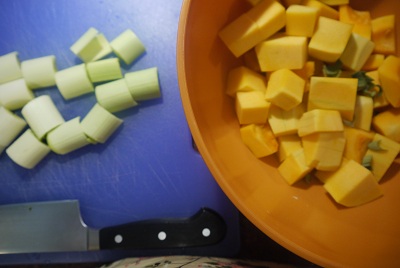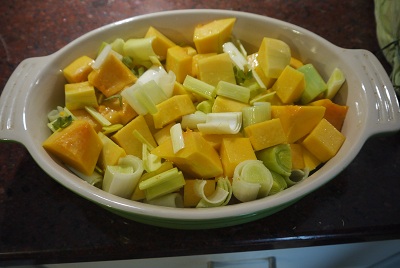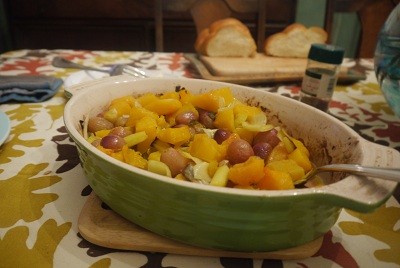My cousin Mark, who is best described as tall, dark, handsome and phenomenally successful, is also the world’s luckiest vegan. I say this based solely on the fact that his mother, Aunt Sydney, is the best cook I know, and she makes sure that his belly is always happy and full when he’s home for a visit. Whether it’s a bowl of fluffy quinoa tabouli for Pesach, or a jar of pickled beets, he is always well-sated.
Aunt Sydney lives only a few blocks from my parents, so when we are all home for the holidays, like we were a few weeks back for Rosh Hashana, the cousins, nieces, nephews, spouses and grandchildren all gather at Sydney’s for an afternoon visit. We try to catch up as best we can. Sometimes there’s plum cake; this year there was stellar mandelbroit. The visit always begins with Sydney asking what Mom served, and us clamoring for her menu.
I actually didn’t hear the full details of her menu on this last visit (I was distracted by the mandelbroit – it was that good), but Miriam, Syl’s wife, reported back to me about one of the vegan dishes she’d served. I honest-to-goodness gasped when I heard about the pan of butternut squash, leeks, sage and grapes, and may have even started to moan when I began to imagine what it must have tasted like. It sounded like pure autumn to me, a perfect harvest dish, which meant that it would be on my Sukkot table.
Sukkot is one of the three Jewish pilgrimage holidays, Pesach and Shavuot being the other two. Like Pesach, it starts with festive holy days (praying, eating, no work), has interim days (more praying, but back to work), and ends with some more holy days. (At some point I’ll write about my favorite holiday of all, Simchat Torah, but one thing at a time.)
Sukkot means, roughly, Feast of Booths, because the Children of Israel were commanded to spend the days of the holiday eating all their meals in a temporary structure, called a sukkah, to remind us of the 40 years in the desert. (Some people also sleep in their sukkahs, although I’ve never done it.) We also have some rituals involving a lulav (a palm branch) and an etrog (a citron), with a few pieces of myrtle and willow leaves tucked in between.
Sorry to bore you with the details, but it’s a really wonderful holiday for the whole family. A definite highlight of being a little kid is making colorful paper chain rings to string throughout the sukkah. We always had a sukkah growing up, and my parents have kindly offered their sukkah to me and Rich. We borrowed someone’s station wagon over Rosh Hashana to bring it back to Boston, but it turns out we’ll need to rent a truck to do it. Someday…
But yes, Sukkot is a harvest holiday, and nearly everything in this dish came in last week’s CSA. When Rich saw me take the dish out of the oven, he made two observations: that it looked like fruit salad at first glance, and that it looked like a Thanksgiving dish to him. Yup, I said, that’s exactly right. It is a Thanksgiving dish.
Aunt Sydney didn’t actually give me a recipe for this dish, but I guessed it in the same way that I guessed how to make her sweet potato and cilantro soup. I’ve taken to waking up earlier than Rich on the weekends, so I had actually cleaned the butternut squash earlier in the day making this a pretty quick dish to put together. Using a sturdy peeler, I simply peeled the squash, cut it in a half at its waistline, sliced those pieces in thirds, scraped out the seeds from its bulb, then cut those into thirds, or approximately two inch cubes.
For the leek, I chopped off the top, peeled away its stiff, dark green outer layers until I got to very pale green part, sliced the leek in half vertically, and ran the stalks under running water and wiped out any dirt stuck in its crevices. To make certain that the leeks wouldn’t burn in a hot oven, I kept those pieces and their layers altogether in rather large pieces, about 2 inches. I intentionally photographed the pieces of leeks so you could see for yourself.
Roasted Butternut Squash with Leeks, Grapes and Sage
Ingredients
1 butternut squash, peeled, seeded and cubed into 2-inch pieces
1 leek, halved, cleaned and sliced into 2-inch pieces
2 sage leaves, sliced into a thin chiffonade
1 cup red grapes, rinsed
2 tablespoons olive oil
Pinch of kosher salt
Directions
Preheat oven to 450. If you didn’t wake up earlier in the day to clean a butternut squash, my advice is to preheat the oven before you prep any of the vegetables.
In a large bowl, toss together the squash, leek, sage, olive oil and salt. Place all ingredients into a roasting pan with sides or medium-sized casserole dish, and cover tightly with foil. Place into the hot oven for approximately 30 minute. At the end of 30 minutes, remove the foil, and give everything a stir. Things should have softened very nicely by now. Remove the pan from the oven and add the washed grapes and give everything a stir. Place the casserole dish, uncovered, back into the oven for approximately 15 minutes more. Your goal at this point is to soften the grapes. In 15 minutes time, check on the pan. If everything is softened, and perhaps a little bit browned, remove from the oven, and serve.








